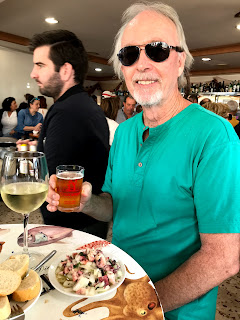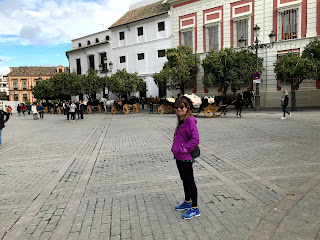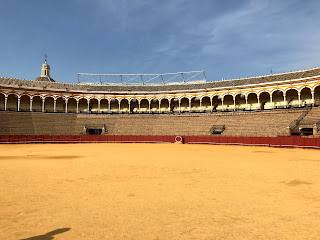Sunday was our last full day in Estepona. After breakfast and doing a bit of packing, we went for our usual walk along the Paseo Maritimo, which takes 55 minutes one way to the little park where we enjoy the sun while we look out over the ocean. The weather has been about 21C and sunny lately.
On the way back, we’ve been stopping for drinks and tapas almost every day at La Escollera near the port. It’s always crowded but today, being Sunday, it was nuts. However, we soon found a couple of stools and ordered drinks, octopus salad and eventually some calamari. The food is great and it’s always an experience in there. The noise level is deafening but we’ve gotten used to it. It’s so crowded the party spills out onto the street. Everyone just keeps going up to the bar ordering tapas and drinks and not paying until they leave. Somehow the servers seem to keep track.
On Monday, December 3rd we turned over our keys to the partner of the property manager who then drove us to the bus station at the east end of Estepona. We had 1 1/2 hours until the bus left at 12:45 pm so we walked a short distance to the little park with the statues by the sea for a last chance to bask in the sun. By 2 pm we were at the airport in Malaga where we caught a city bus to the Holiday Inn Express, 5 minutes away. We nestled in for the night and had snacks in our room for dinner, since the hotel was located in a wasteland of car rentals and small warehouses.
On Tuesday morning we were up before 6 am to get the included breakfast at 7 am. After checking out shortly after 8, we walked a few minutes to the bus stop and caught a city bus (3 euros each) back to the airport. Check-in, security and customs went smoothly and our flight took off at 11:40 am. After 8 hours and several movies that one would only watch on a plane, we arrived in Montreal at 1:50 pm. Again, customs and baggage retrieval went smoothly. We found the Greyhound ticket booth and bought tickets ($30 each) on the 3:25 pm bus to Ottawa, which finally left at 3:45 pm.
We arrived in Ottawa a little after 6 pm. Our youngest son, Dylan, met us at the station and drove us to our oldest son Zack’s in Gatineau for the night. We were up with our grandchildren shortly after 5 am and on the road home in our car before 8. By 11 am, we were home for the first time in a month, tired but satisfied with another great trip.
Our final thoughts about Andalusia:
We really enjoyed seeing the Moorish architecture and the later buildings after the Christian Reconquest that were built by spending gold from the conquest of the Americas. Gibraltar was worth seeing but only barely. The Costa del Sol was very pleasant but not the sort of place we would ever go for a beach holiday when the Caribbean is so available to us.
What we saw of Spain was very clean and pleasant. The cities are very pedestrian friendly. The buses are clean, efficient and cheap. The food and wine are excellent. From the moment we left home until the moment we got back, the whole trip cost us $5,500 Canadian.
Maybe someday we’ll go back, probably to the Madrid area.
On the way back, we’ve been stopping for drinks and tapas almost every day at La Escollera near the port. It’s always crowded but today, being Sunday, it was nuts. However, we soon found a couple of stools and ordered drinks, octopus salad and eventually some calamari. The food is great and it’s always an experience in there. The noise level is deafening but we’ve gotten used to it. It’s so crowded the party spills out onto the street. Everyone just keeps going up to the bar ordering tapas and drinks and not paying until they leave. Somehow the servers seem to keep track.
On Monday, December 3rd we turned over our keys to the partner of the property manager who then drove us to the bus station at the east end of Estepona. We had 1 1/2 hours until the bus left at 12:45 pm so we walked a short distance to the little park with the statues by the sea for a last chance to bask in the sun. By 2 pm we were at the airport in Malaga where we caught a city bus to the Holiday Inn Express, 5 minutes away. We nestled in for the night and had snacks in our room for dinner, since the hotel was located in a wasteland of car rentals and small warehouses.
On Tuesday morning we were up before 6 am to get the included breakfast at 7 am. After checking out shortly after 8, we walked a few minutes to the bus stop and caught a city bus (3 euros each) back to the airport. Check-in, security and customs went smoothly and our flight took off at 11:40 am. After 8 hours and several movies that one would only watch on a plane, we arrived in Montreal at 1:50 pm. Again, customs and baggage retrieval went smoothly. We found the Greyhound ticket booth and bought tickets ($30 each) on the 3:25 pm bus to Ottawa, which finally left at 3:45 pm.
We arrived in Ottawa a little after 6 pm. Our youngest son, Dylan, met us at the station and drove us to our oldest son Zack’s in Gatineau for the night. We were up with our grandchildren shortly after 5 am and on the road home in our car before 8. By 11 am, we were home for the first time in a month, tired but satisfied with another great trip.
Our final thoughts about Andalusia:
We really enjoyed seeing the Moorish architecture and the later buildings after the Christian Reconquest that were built by spending gold from the conquest of the Americas. Gibraltar was worth seeing but only barely. The Costa del Sol was very pleasant but not the sort of place we would ever go for a beach holiday when the Caribbean is so available to us.
What we saw of Spain was very clean and pleasant. The cities are very pedestrian friendly. The buses are clean, efficient and cheap. The food and wine are excellent. From the moment we left home until the moment we got back, the whole trip cost us $5,500 Canadian.
Maybe someday we’ll go back, probably to the Madrid area.






















































